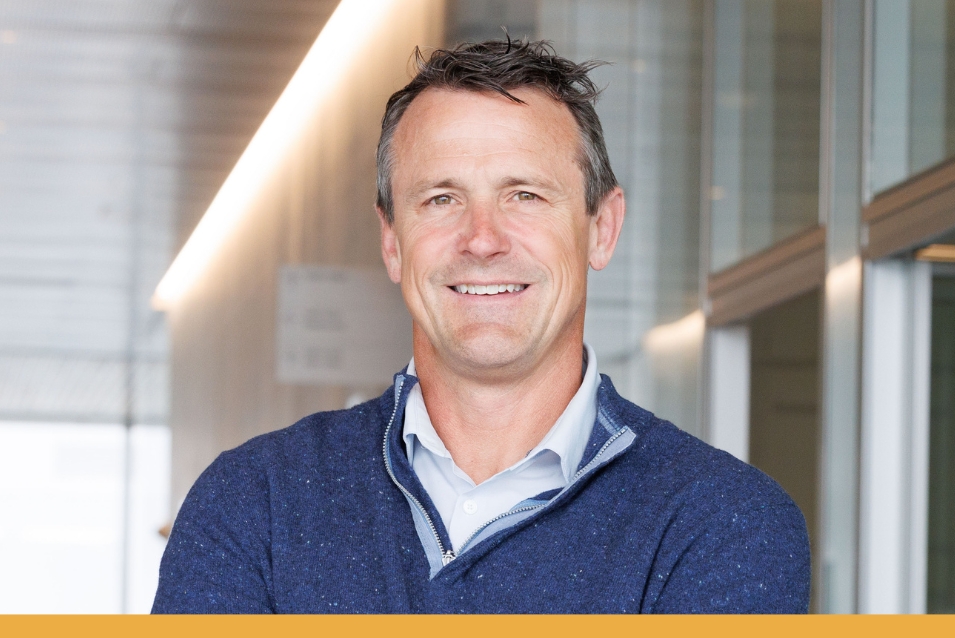
MedTech Innovation and Behavioral Science with Matthew Hinton, MBA '03
- What motivated you to take the executive education program at this point in your journey?
- What was it like returning to campus—and seeing the new Manhattanville location?
- How did the program expand on your MBA foundation?
- With your experience in healthcare innovation, what behavioral challenges were you looking to explore?
- Were there specific concepts that resonated with your work in medtech or healthcare services?
- Have you already begun applying the tools or insights in your work?
- What changes have you seen so far in how your team is approaching the product launch?
- What would you say to fellow alumni about returning for executive education?
Q&A with Matthew Hinton, MBA '03
With a career rooted in medtech and healthcare solutions, Matthew Hinton has long been focused on improving quality, cost, and patient experience through sales strategy and innovation. As he embarks on launching a new platform that uses machine learning to optimize sell-side analytics in healthcare, he returned to Columbia Business School for the Behavioral Science in Business program.
We asked Matthew to share how behavioral science is helping him sharpen strategy, elevate stakeholder influence, and launch products with impact.

What motivated you to take the executive education program at this point in your journey?
I'm currently building a business focused on medtech sell-side analytics using machine learning. In healthcare, particularly with multi-stakeholder negotiations between hospitals and providers, success requires more than data—it requires understanding human behavior, decision-making channels, and how to drive alignment. I needed a more structured lens to tackle influence, bias, group consensus, and governance. This program offered the strategic rigor to build that organizational muscle.
What was it like returning to campus—and seeing the new Manhattanville location?
It was invigorating. The new campus on the Hudson River is a huge upgrade from Uris Hall. It’s modern, open, and tech-enabled—designed for collaborative learning. I especially appreciated the breakout spaces and panoramic views of the city. Beyond the classroom, I loved the energy of walking through Harlem. The whole experience felt current, global, and deeply connected to New York.
How did the program expand on your MBA foundation?
It broadened how I think about influence and persuasion in business. Full Cycle Approach to Applying Behavioral Science™ was especially valuable—it provides a practical framework for solving messy, real-world challenges where discretion and organic decision-making dominate. It helped me see how behavioral science can be systematically applied to drive sales outcomes.
With your experience in healthcare innovation, what behavioral challenges were you looking to explore?
Our platform is designed to help internal teams and external stakeholders reframe transactions and drive better outcomes. But adoption isn’t easy—particularly in complex environments where stakeholders are risk-averse or resistant to change. Both internal champions and external buyers have competing truths and motivations. To succeed, our solution must be both credible and predictive. This program helped me build a roadmap to navigate that behavioral complexity.
Were there specific concepts that resonated with your work in medtech or healthcare services?
Absolutely. The Full Cycle Approach to Applying Behavioral Science™ is a modern evolution of classic influence principles—it’s a toolkit for understanding how people truly make decisions, especially in high-stakes or high-friction scenarios. For those who admire Dale Carnegie’s How to Win Friends and Influence People, this program offers a sophisticated, modern upgrade rooted in current research. It’s built for complexity and gives leaders a structured way to guide change across diverse constituents.
Have you already begun applying the tools or insights in your work?
Yes—in fact, just today I was working with a colleague on how to navigate a key stakeholder who is particularly skeptical of data. I drew from the program’s principles—specifically around Liking, Unity, and surround-sound influence strategies. It gave us a multi-faceted approach we wouldn't have otherwise considered.
What changes have you seen so far in how your team is approaching the product launch?
While our platform hasn’t officially launched yet, I can already see how the behavioral science lens is shaping our go-to-market strategy. We’re building our hypotheses using a more holistic model that reduces blind spots. Instead of relying on gut instinct, we now have a structure to test and refine our approach before we scale.
What would you say to fellow alumni about returning for executive education?
Just like with the MBA, the return on investment is what you make of it. For me, this course will more than pay for itself by accelerating the trajectory of our product launch. The behavioral science tools I gained are already shifting how we build, persuade, and execute. Feel free to connect with me via email.
Sign Up for Email Alerts
Sign up for program updates and content relevant to today's business leaders from Columbia Business School Executive Education.
